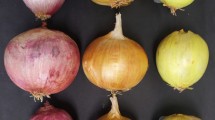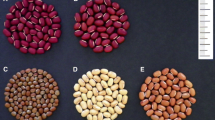Summary
1. The inter-barbadense cross Egyptian brown × Sea Island white gaveF 1 intermediate and complicated segregation of the blending type inF 2. This was demonstrated to be due to the fact that the factorK B of the brown parent was accompanied by a number of plus modifiers absent in the white parent.
2. Repeated back-crossing of heterozygotes to the brown parent had the effect of equalising the plus modifiers of both the dominant and recessive phases of the factorK B. Selfing after three back-crosses gave simple segregation into 3 brown: 1 light brown.
3. A negative correlation was shown to exist between lint colour and lint length, the factorK B or a factor closely linked to it conditioning a shortening in the lint length of approximately 5·1 mm. in the homozygous phase and 2·7 mm. in the heterozygous phase.
4. Minor colour factors were also correlated with variations in lint length.
5. The blending type of inheritance of brown lint in Egyptian × Sea Island is considered to be due to the disintegration by human agency of an original brown-lint factor complex.
6. The cross of brownbarbadense × brownhirsutum was found to involve duplicate genes for lint colour. The distribution of the known pairs of duplicate genes inG. barbadense andG. hirsutum is discussed.
Similar content being viewed by others
References
Brown, H. B. (1927).Cotton. New York: McGraw-Hill Book Co.
Harland, S. C. (1932). “The genetics ofGossypium.”Bibliogr. genet. 9, 107–82.
Kottur, G. L. (1923). “Studies in inheritance in cotton. History of a cross betweenGossypium herbaceum andGossypium neglectum.”Mem. Dep. Agric. India, Bot.,12, 71–133, illus.
Skovsted, A. (1934). “Cytological studies in cotton. II. Two interspecific hybrids between Asiatic and New World cottons.”J. Genet. 28, 407–24.
Thadani, K. I. (1923). “Linkage relations in the cotton plant.”Agric. J. India,18, 572–9.
Ware, J. O. (1932). “Inheritance of lint colours in Upland cotton.”J. Amer. Soc. Agron. 24, 550–62.
Author information
Authors and Affiliations
Rights and permissions
About this article
Cite this article
Harland, S.C. The genetics of cotton. Journ. of Genetics 31, 27–37 (1935). https://doi.org/10.1007/BF02982277
Issue Date:
DOI: https://doi.org/10.1007/BF02982277




